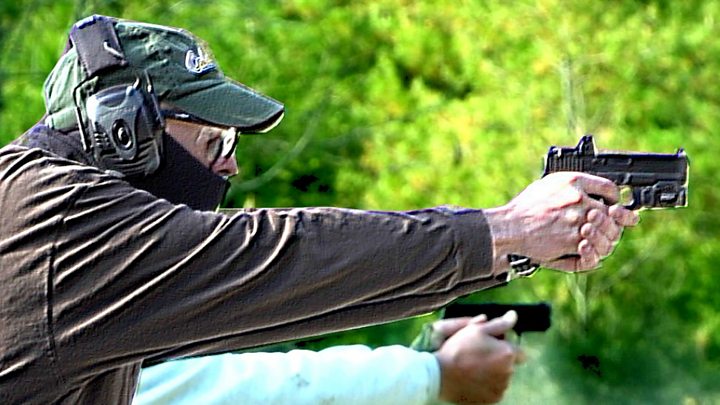Inside a US training course to arm teachers
In 14 US states, there are already schools in which some teachers carry guns. Before they can be armed in the classroom, teachers in one of those states, Ohio, go through a three-day training course.
An estimated 400 more teachers have gone through that training there this year. I joined the latest group of Ohio teachers trying to qualify to carry a gun in the classroom.
There were simulated scenarios the teachers were put through in which they would be expected to use their weapon.
This is how these scenarios unfolded.
Scenario 1: The active shooter
On a cold day deep in the southern Ohio countryside, I stood waiting outside a fake school building next to a teacher with a replica gun. He was nervous, waiting for the scenario to start, wondering what kind of situation he would have to deal with.
For security reasons, we are not allowed to name the teachers who might go back to their classrooms armed but this teacher was a softly-spoken school principal who felt he could not ask members of his staff to carry guns if he did not carry a weapon himself.
“Our school is in a rural area, police officers could take anywhere from 15-20 minutes to get to us and in a school shooting it’s over and done with by then,” the head teacher said, explaining why he felt compelled to apply to carry a gun.
“Scenario start!” shouted one of the trainers and we ran into the “school” together.
A woman ran past us screaming that something terrible was happening down the corridor where we could hear shouting. Further on, the teacher I’d spoken to outside had his gun raised out in front of him.
Suddenly, two “children” ran out of a classroom shouting.
“Click, click”
In the stress of this fake situation, the teacher had accidentally shot both of the innocent “students”.
He then went on and entered the classroom, identified the attacker and within a matter of seconds “killed” him too.
After the exercise, I put it to Joe Eaton who ran the course that this could happen for real and innocent students could be killed.
“There is nothing that is 100%,” said Mr Eaton.
“One thing we know for certain is that killing will continue until [the teacher] stops it. We have people say before ‘I don’t want my kids in the middle of a gun fight’ but until you have somebody there to respond, they are not in a gun fight – they are in a firing squad.”
Qualification of the course is based solely on target practice – 26 hits out of 28 shots at a human-shaped target, and the teacher passes.
A few hours after the scenario I had witnessed, the head teacher who “killed” two students involved passed the course.
Scenario 2: The school fight
In the second scenario, two “school students” were having a fight in a classroom, surrounded by other children who were spurring them on.
“Scenario start!”
We went in – this time with a different armed teacher from the first scenario. He approached the fight. Very suddenly one of the students pulls out a knife and stabs the other.
“Click, click, click”
Within moments, the student who pulled out the knife is shot dead by her teacher.
“Clean shots, clean hits, nicely done” says Forrest Sonewald, the lead trainer, ending the exercise.
But after the scenario, the teacher who pulled the trigger voices his unease.
“Just because I see a knife is that a reason to pull the trigger?” he asked. “She wasn’t coming at me, so I did hesitate just a little bit.”
Another trainer interjects. “That’s why you’re learning, to know not to [hesitate]” he said, before elaborating.
“How much can the average person cover in two seconds with that bladed implement in their hand – especially high school age kids?” he asks.
“Easily 20 feet plus, so that is a lethal force implement,” he continues, reinforcing his justification that shooting dead the student with the knife is the right thing to do.
Mr Sonewald tells of how teachers from a previous group said it was their school’s policy for teachers to only use a gun when a firearm was involved in an attack, something he derided.
“Good luck if you’re going to be bludgeoned by a brick!”
Lingering anxieties
At the end of the course, another middle-school principal asked something that had been troubling him.
“What if you are in the cafeteria and a student would raise a gun, and he points it at people, and you take him down and it ends up being a toy gun?”
Mr Sonewald answered.
“No, no, you are defending everybody else and in that case you have identified what would appear to be a clear threat. There is already case law established like that for police officers,” he said.
There were other moments during the course when the teachers were encouraged to shoot rather than do nothing, and talk of the protection offered by US law.
Speaking to the head teacher later, it was clear he was still troubled.
“If we are going to pull the trigger we want to make sure it is worth everything. It is tough to think about that it might be a kid that you know [that is the attacker]. A kid that you see every day,” he told me.
This particular teacher had never owned a gun before now and had had very little experience with firearms. He also passed the course and, once his school approves it, can carry a gun in his classroom.
Finally, I spoke to an IT teacher, moments after he had hit the required number of shots at the target and had qualified as well.
He appeared more pensive than pleased and I asked him why.
“Well it’s an enormous amount of responsibility,” he told me, reflecting on the fact that he would be the first teacher to be armed at his school.
He had volunteered because, he said, the school had wanted to do something to prepare for the possibility of an attack and wanted volunteers and no one else had raised their hand.
“I know that if you are that person, you have a high probability you are going to get shot if an attack happens. It’s not a great thought, it messes with you.”
Source: Read Full Article




